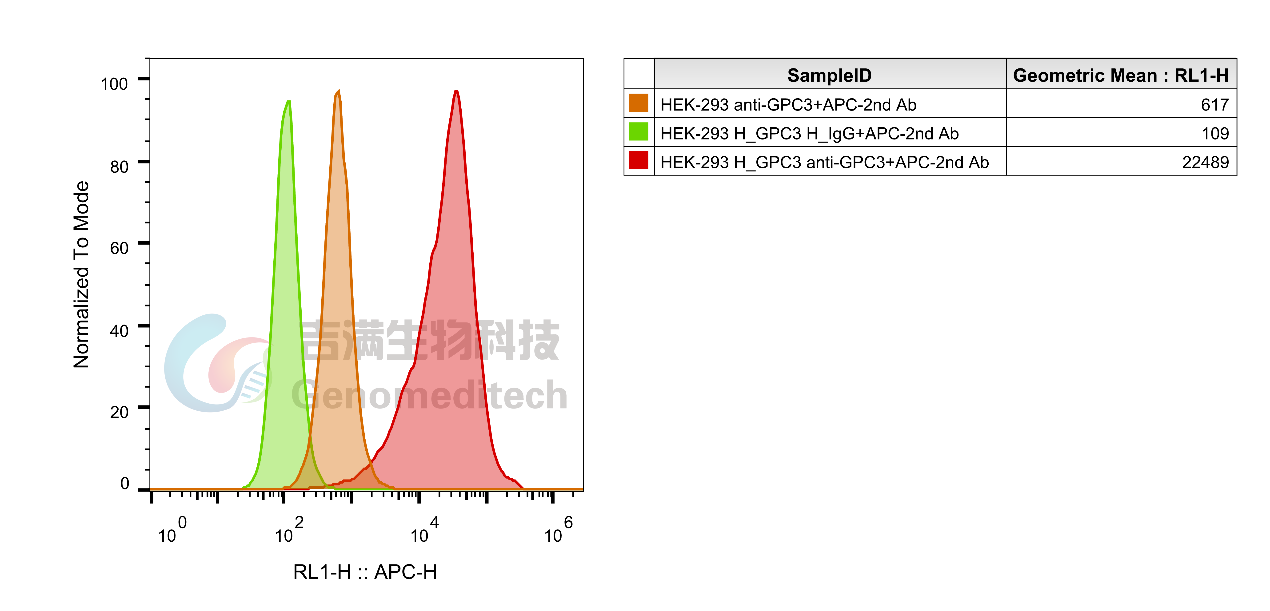Cat. No:GM-28751AB
Product:Anti-GPC3 hIgG1 Antibody(Codrituzumab)
Cat. No:GM-28751AB
Product:Anti-GPC3 hIgG1 Antibody(Codrituzumab)
GM-28751AB-10 10 μg
GM-28751AB-100 100 μg
GM-28751AB-1000 1mg
Species Reactivity Human
Clone Codrituzumab
Source/Isotype Monoclonal Human IgG1 /κ
Application Flow Cytometry
Specificity Detects GPC3
Gene GPC3
Other Names DGSX, GTR2-2, MXR7, OCI-5, SDYS, SGB, SGBS, SGBS1
Gene ID 2719
Background The protein core of GPC3 consists of two subunits, where the N-terminal subunit has a size of ~40 kDa and the C-terminal subunit is ~30 kDa. Six glypicans (GPC1-6) have been identified in mammals. Cell surface heparan sulfate proteoglycans are composed of a membrane-associated protein core substituted with a variable number of heparan sulfate chains. Members of the glypican-related integral membrane proteoglycan family (GRIPS) contain a core protein anchored to the cytoplasmic membrane via a glycosyl phosphatidylinositol linkage. These proteins may play a role in the control of cell division and growth regulation. GPC3 has been found to regulate Wnt/β-catenin and Yap signaling pathways. GPC3 interacts with both Wnt and frizzled (FZD) to form a complex and triggers downstream signaling. The core protein of GPC3 may serve as a co-receptor or a receiver for Wnt. A cysteine-rich domain at the N-lobe of GPC3 has been identified as a hydrophobic groove that interacts with Wnt3a. Blocking the Wnt binding domain on GPC3 using the HN3 single domain antibody can inhibit Wnt activation. Wnt also recognizes a heparan sulfate structure on GPC3, which contains IdoA2S and GlcNS6S, and that the 3-O-sulfation in GlcNS6S3S significantly enhances the binding of Wnt to heparan sulfate. GPC3 also modulates Yap signaling. It might interact with FAT1 on the cell surface
Storage Store at 2-8℃ short term (1-2 weeks).Store at ≤ -20℃ long term. Avoid repeated freeze-thaw.
Formulation Phosphate-buffered solution, pH 7.2.
Endotoxin < 1 EU/mg, determined by LAL gel clotting assay

Cat. No:GM-28751AB
Product:Anti-GPC3 hIgG1 Antibody(Codrituzumab)
GM-28751AB-10 10 μg
GM-28751AB-100 100 μg
GM-28751AB-1000 1mg
Species Reactivity Human
Clone Codrituzumab
Source/Isotype Monoclonal Human IgG1 /κ
Application Flow Cytometry
Specificity Detects GPC3
Gene GPC3
Other Names DGSX, GTR2-2, MXR7, OCI-5, SDYS, SGB, SGBS, SGBS1
Gene ID 2719
Background The protein core of GPC3 consists of two subunits, where the N-terminal subunit has a size of ~40 kDa and the C-terminal subunit is ~30 kDa. Six glypicans (GPC1-6) have been identified in mammals. Cell surface heparan sulfate proteoglycans are composed of a membrane-associated protein core substituted with a variable number of heparan sulfate chains. Members of the glypican-related integral membrane proteoglycan family (GRIPS) contain a core protein anchored to the cytoplasmic membrane via a glycosyl phosphatidylinositol linkage. These proteins may play a role in the control of cell division and growth regulation. GPC3 has been found to regulate Wnt/β-catenin and Yap signaling pathways. GPC3 interacts with both Wnt and frizzled (FZD) to form a complex and triggers downstream signaling. The core protein of GPC3 may serve as a co-receptor or a receiver for Wnt. A cysteine-rich domain at the N-lobe of GPC3 has been identified as a hydrophobic groove that interacts with Wnt3a. Blocking the Wnt binding domain on GPC3 using the HN3 single domain antibody can inhibit Wnt activation. Wnt also recognizes a heparan sulfate structure on GPC3, which contains IdoA2S and GlcNS6S, and that the 3-O-sulfation in GlcNS6S3S significantly enhances the binding of Wnt to heparan sulfate. GPC3 also modulates Yap signaling. It might interact with FAT1 on the cell surface
Storage Store at 2-8℃ short term (1-2 weeks).Store at ≤ -20℃ long term. Avoid repeated freeze-thaw.
Formulation Phosphate-buffered solution, pH 7.2.
Endotoxin < 1 EU/mg, determined by LAL gel clotting assay
